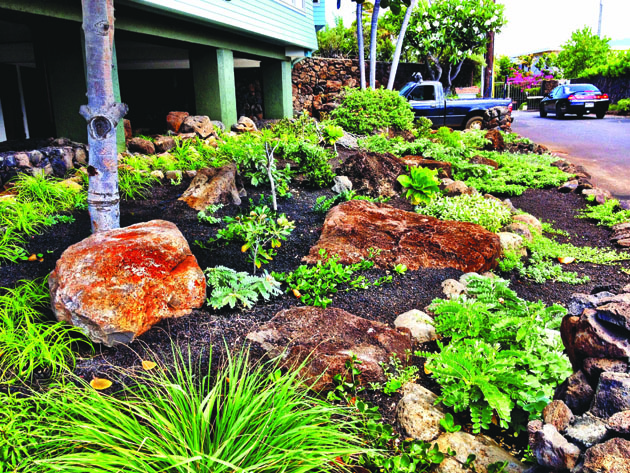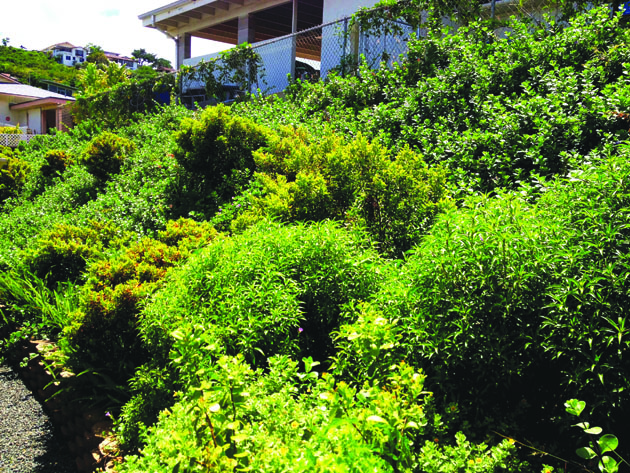Stick out your green thumb and hitch a ride on the green landscape movement. You’re going to dig it.
Traditional landscaping has its baggage: dangerous chemicals, harmful techniques and the constant need to introduce new resources like synthetic fertilizers. However, homeowners (and even renters) have the opportunity to turn over a new leaf by following down the path of green landscaping. The following suggestions can make your yard green in an ecologically friendly way, and save you energy and money without sacrificing on looks.

Grown and planted by Hui Ku Maoli Ola, native plants take root and form vital part of a low maintenance landscape.
1. Go native
A key part of green landscaping is the use of native plants. While our lush island paradise appears to be teeming with life, Hawaii’s native ecosystems, which exist nowhere else in the world, are loosing their foothold. It’s a devastating fact that Hawaii is the endangered species capital of the world.
Restore lost habitat by turning your yard into a haven for natives. Rick Barboza, partner of Hui Ku Maoli Ola, is in expert in Hawaiian plants. He and his team convert existing landscapes into native habitats by introducing plants that would have naturally occurred in the region before development, one thousand years ago.
Drawing from the company’s nursery, Barboza and the team rehabilitate yards with plants specifically adapted to the area. According to Barboza, you’ll be doing your part to contribute to the overall improvement of Hawaii’s natural ecology while also enjoying a low maintenance yard. Plus, native plants are less aggressive than weedy invasive plants and less likely to escape your yard and spread unwanted to other areas.
Buyers beware, however. Make sure you do thorough research or hire an expert in native Hawaiian plants when going native. Plumeria, pikake, ginger, heleconia and bird of paradise, just to name a few, are nonnative exotics. And some plant sellers are falsely labeling their plants as native.
2. The great xeriscape
When people think of xeriscaping, a water-conservative landscaping practice derived from the Greek word for “dry,” the mental image that crops up may be of cactus and succulents. But going green in your yard doesn’t have to involve the prickly stuff.
It all depends on you the microclimate you house is situated in. If you live on the wet side, then xeriscaping in your case would mean plants that thrive in an area of higher rainfall. Plants that are adapted to your area will be happy with what they get, and require, if at all, little watering. As a bonus, the need for less water means nutrients stay in your soil — plants dig it.
If you need to water do so in the early morning or late afternoon when it’s less hot, and use drip irrigation or a soaker hose, not a sprinkler, so water makes it down to the roots instead of evaporating off the top of plants.
3. Don’t go with the flow
Your soil is as good as gold, so don’t let your investment wash away with the next heavy rainfall. Erosion is a serious problem with far-reaching affects to water quality; it muddies waterways and smothers coral. Erosion can occur across a broad area, but there’s something you can do on an individual level — cover up. On bare soil, plant groundcover with fibrous roots and dense foliage that will stand its ground against rainfall; it’s the best defense against erosion. “When it rains it’s the actual individual rain drops that dislodges the surface soil that causes it to runoff eventually,” said Barboza. Xeriscaping practices, which prevent overwatering, will also help hold on.

Here’s the dirt on erosion: Plant groundcover, like these grown by Hui Ku Maoli Ola, and “stick it” to the soil.
4. Double duty
Make features in your yard pull double duty without giving up on beauty.
Incorporate edible plants in an aesthetically pleasing and functional way. Barboza suggests planting native cultivars, which are the plants the ancient Hawaiians carried here via canoes: taro, breadfruit and Hawaiian sweet potato, for example. Turning your landscape edible will save you trips to the grocery store and, in the case of native cultivars, preserve a historic taste of Hawaii.
And don’t forget the mulch. It’s a modest addition to your yard that will cool soil, prevent weeds, reduce water loss and control erosion. Use grass clippings, wood chips, stones or even Macadamia nut shells to do the multitask.
5. For the birds
If you plant them, they will come. The birds and bees that is! If you love the idea of bringing nature right to your door, then grow native plants. You’ll be creating a mini kipuka, or oasis, for native fauna and insects to forage and also reaping the benefits of a more interesting window scene.
Bringing the birds back was one of the main reasons that Barboza started the native Hawaii plant restoration company. “I always wanted to have native birds at my parent’s house, but I knew that none of the plants that were currently there would ever attract the native birds,” said Barboza.